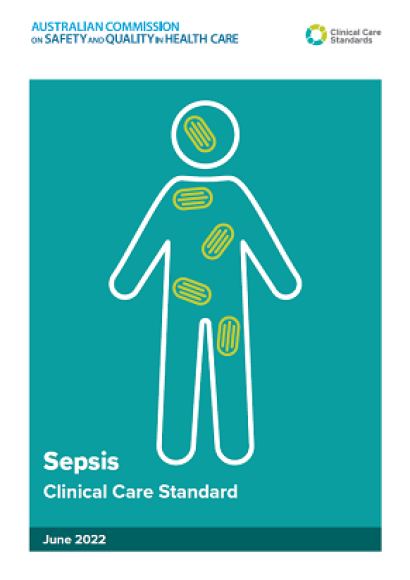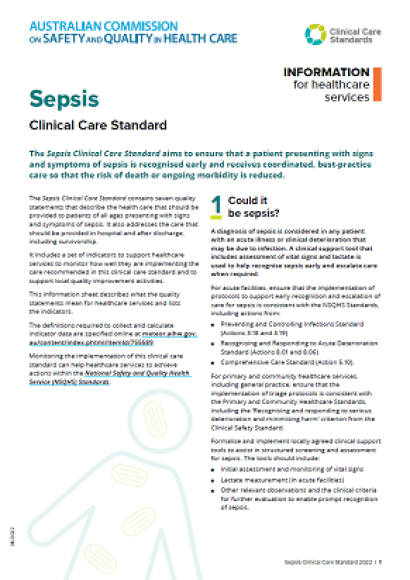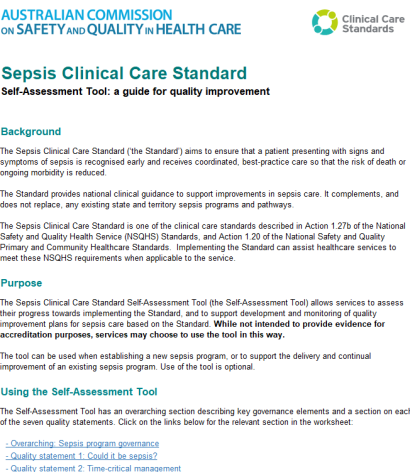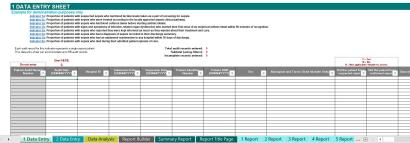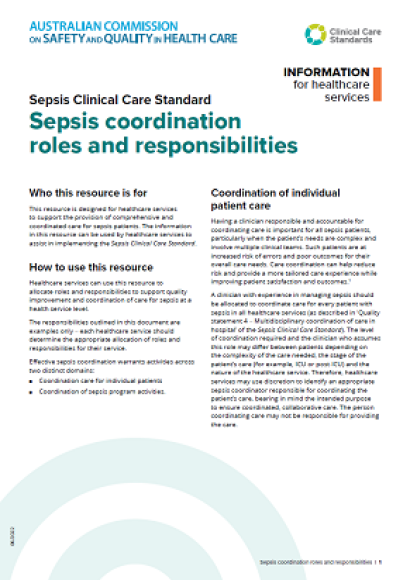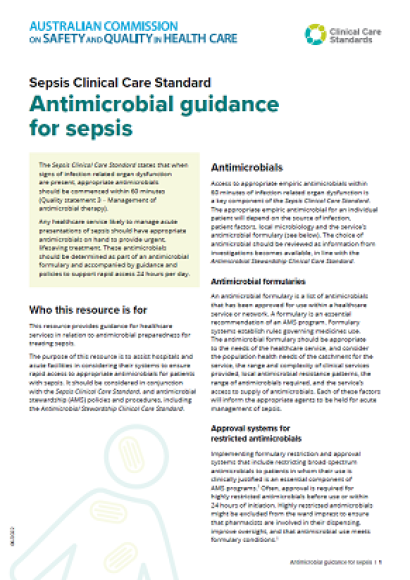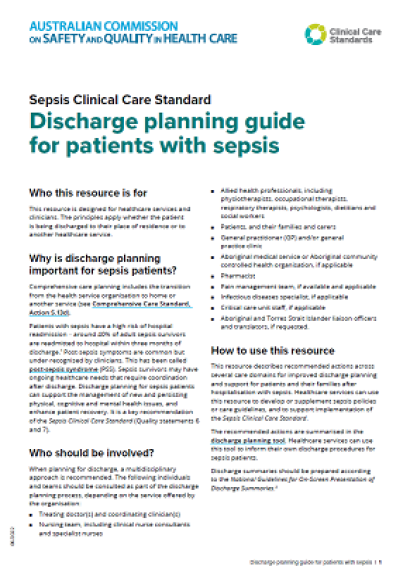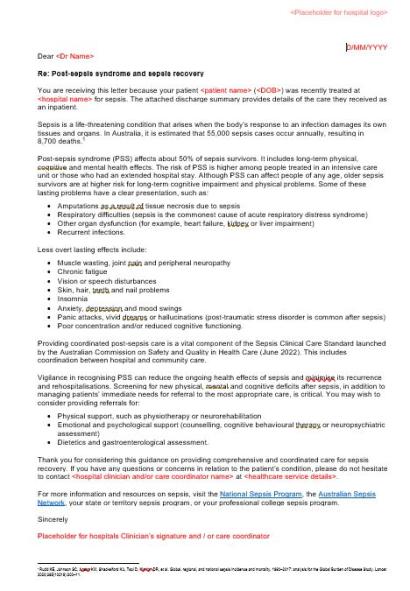Information for healthcare services - Sepsis Clinical Care Standard
Information for healthcare services to guide practice and monitor improvement using the clinical care standard, and resources to support implementation.
The quality statements in the Sepsis Clinical Care Standard describe the expected standard for key components of patient care. The information below explains what each statement means for healthcare services including the policies, procedures and organisational factors that can enable the delivery of high-quality care. Key considerations in regard to cultural safety and equity are also included for several statements.
Indicators are available to help health service organisations monitor how well they are implementing the care recommended in the clinical care standard.
Quality statements
Communications resources
A communications kit has been developed to support the launch of the Clinical Care Standard. Show your support for the clinical care standard by downloading and sharing the content on your website, social networks or within your health service organisation.
Resources for healthcare services
The resources below will support healthcare services to implement the Sepsis Clinical Care standard.
Other implementation resources are also available including guidance for clinicians on lactate in the deteriorating patient, and resources for consumers. Educational tools including case studies and podcasts are also available, as well as links to state and territory pathways and other related resources from the Sepsis Clinical Care Standard.
-
2022Publication, report or update
The Sepsis Clinical Care Standard contains seven quality statements and a set of indicators to ensure sepsis is recognised early and patients receive coordinated, best-practice care to reduce the risk of death or ongoing morbidity.
-
2022Fact sheet or brochure
This resource accompanies the Sepsis Clinical Care Standard. It describes what the quality statements mean for healthcare services and provides indicators to support local quality improvement activity. It outlines key considerations for healthcare services in regard to equity and cultural safety.
-
2022Audit, monitoring or reporting tool
This self-assessment tool supports the development and monitoring of quality improvement plans for sepsis care by allowing services to assess their progress towards implementing key elements of the Sepsis Clinical Care Standard. The Sepsis Clinical Care Standard Self-Assessment Tool can be used when establishing a new sepsis program, or to support the delivery and continual improvement of an existing sepsis program.
-
2022Audit, monitoring or reporting tool
The Indicator Monitoring Tool is a data repository, analysis and reporting tool for the Sepsis Clinical Care Standard indicators. It can be used by healthcare services to capture and audit individual patient data, examine results and identify targets for improvement. A Quick Reference Guide and a demonstration version of the Indicator Monitoring Tool using sample data are available to support the use of the tool.
-
2022Fact sheet or brochure
Guidance for healthcare services on allocating roles and responsibilities to support quality improvement and coordination of care for sepsis.
-
2022Fact sheet or brochure
Guidance for hospitals and acute facilities about systems to ensure rapid access to appropriate antimicrobials for patients with sepsis, including use and governance of sepsis boxes.
-
2022Fact sheet or brochure
Recommendations for multidisciplinary discharge planning to ensure follow up and support for patients and their families after hospitalisation with sepsis - including a discharge checklist.
-
2022Template, survey or form
This template letter can be used by healthcare services to communicate with a patient’s general practitioner on discharge following hospitalisation for sepsis. It contains information about post-sepsis syndrome and sepsis recovery.
Meeting the requirements of national standards and accreditation
Implementing this clinical care standard as part of a quality improvement activity can help healthcare services meet the requirements of the National Safety and Quality Health Service (NSQHS) Standards, and the National Safety and Quality Primary and Community Healthcare Standards (Primary and Community Healthcare Standards).
Within both sets of standards, the Clinical Governance Standard and the Partnering with Consumers Standard set the overarching requirements, or clinical governance framework, for the effective implementation of the other standards.
National Safety and Quality Health Service Standards
Implementation of the Sepsis Clinical Care Standard aligns with specific actions in the NSQHS Standards. In addition, some of the care described in this clinical care standard will help healthcare services to meet requirements of the NSQHS Standards.
Relevant actions
Under the Clinical Governance Standard, healthcare services are expected to:
- Support clinicians to use the best available evidence, including clinical care standards (Action 1.27b)
- Monitor and respond to unwarranted clinical variation (Action 1.28).
Specific actions within the NSQHS Standards that are relevant to this clinical care standard include:
- Preventing and Controlling Infections Standard
- Standard and transmission-based precautions: Actions 3.06, 3.07, 3.08 and 3.09
- Antimicrobial stewardship: Actions 3.18 and 3.19
- Comprehensive Care Standard
- Collaboration and teamwork: Action 5.05
- Screening of risk: Action 5.10
- Communicating for Safety Standard
- Applying quality improvement systems: Action 6.02
- Clinical handover: Actions 6.07 and 6.08
- Communicating critical information: Actions 6.09 and 6.10
- Documentation of information: Action 6.11
- Recognising and Responding to Acute Deterioration Standard
- Integrating clinical governance: Action 8.01
- Escalating care: Actions 8.06, 8.07, 8.08 and 8.09
- Responding to deterioration: Actions 8.10 and 8.11.
Healthcare services are expected to implement the NSQHS Standards in a way that is appropriate to the clinical services provided and their associated risks.
For more information about:
- Assessment to the NSQHS Standards and applicability of clinical care standards, visit the NSQHS Standards webpage
- Monitoring and responding to unwarranted clinical variation, see the NSQHS Standards User Guide for the Review of Clinical Variation in Health Care
- Other relevant actions in the NSQHS Standards.
National Safety and Quality Primary and Community Healthcare Standards
The Primary and Community Healthcare Standards are aligned to the NSQHS Standards.
Relevant actions
Under the Clinical Governance Standard, healthcare services are expected to:
- Support healthcare providers to use best-practice guidelines and available evidence, including clinical care standards (such as the Sepsis Clinical Care Standard), where relevant: Action 1.20b
- Monitor and respond to unwarranted clinical variation: Action 1.21.
Specific actions that are relevant to this clinical care standard include:
- Antimicrobial stewardship: Action 3.14
- Recognising serious deterioration or distress and escalating care: Action 3.31.
Application of the Primary and Community Healthcare Standards is voluntary. They should only be applied where services are involved in the direct care of patients. The way in which an individual primary and/or community healthcare service implements the Primary and Community Healthcare Standards will be dependent on the size of the healthcare service, as well as the risks and complexity associated with the services it delivers.
More information about the Primary and Community Healthcare Standards is available at the Primary and Community Health Service Standards webpage.
National Safety and Quality Health Service Standards
Implementation of the Sepsis Clinical Care Standard aligns with specific actions in the NSQHS Standards. In addition, some of the care described in this clinical care standard will help healthcare services to meet requirements of the NSQHS Standards.
Relevant actions
Under the Clinical Governance Standard, healthcare services are expected to:
- Support clinicians to use the best available evidence, including clinical care standards (Action 1.27b)
- Monitor and respond to unwarranted clinical variation (Action 1.28).
Specific actions within the NSQHS Standards that are relevant to this clinical care standard include:
- Preventing and Controlling Infections Standard
- Standard and transmission-based precautions: Actions 3.06, 3.07, 3.08 and 3.09
- Antimicrobial stewardship: Actions 3.18 and 3.19
- Comprehensive Care Standard
- Collaboration and teamwork: Action 5.05
- Screening of risk: Action 5.10
- Communicating for Safety Standard
- Applying quality improvement systems: Action 6.02
- Clinical handover: Actions 6.07 and 6.08
- Communicating critical information: Actions 6.09 and 6.10
- Documentation of information: Action 6.11
- Recognising and Responding to Acute Deterioration Standard
- Integrating clinical governance: Action 8.01
- Escalating care: Actions 8.06, 8.07, 8.08 and 8.09
- Responding to deterioration: Actions 8.10 and 8.11.
Healthcare services are expected to implement the NSQHS Standards in a way that is appropriate to the clinical services provided and their associated risks.
For more information about:
- Assessment to the NSQHS Standards and applicability of clinical care standards, visit the NSQHS Standards webpage
- Monitoring and responding to unwarranted clinical variation, see the NSQHS Standards User Guide for the Review of Clinical Variation in Health Care
- Other relevant actions in the NSQHS Standards.
National Safety and Quality Primary and Community Healthcare Standards
The Primary and Community Healthcare Standards are aligned to the NSQHS Standards.
Relevant actions
Under the Clinical Governance Standard, healthcare services are expected to:
- Support healthcare providers to use best-practice guidelines and available evidence, including clinical care standards (such as the Sepsis Clinical Care Standard), where relevant: Action 1.20b
- Monitor and respond to unwarranted clinical variation: Action 1.21.
Specific actions that are relevant to this clinical care standard include:
- Antimicrobial stewardship: Action 3.14
- Recognising serious deterioration or distress and escalating care: Action 3.31.
Application of the Primary and Community Healthcare Standards is voluntary. They should only be applied where services are involved in the direct care of patients. The way in which an individual primary and/or community healthcare service implements the Primary and Community Healthcare Standards will be dependent on the size of the healthcare service, as well as the risks and complexity associated with the services it delivers.
More information about the Primary and Community Healthcare Standards is available at the Primary and Community Health Service Standards webpage.

